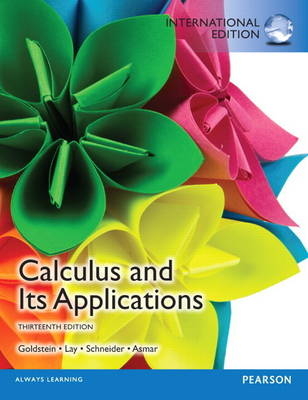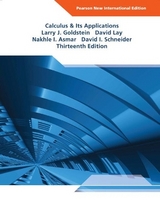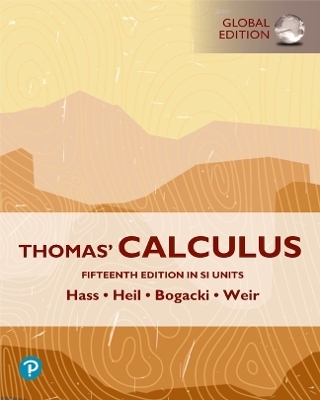
Calculus&Applications, plus MyMathLab with Pearson eText
Pearson Education Limited
978-1-4479-5311-1 (ISBN)
- Titel erscheint in neuer Auflage
- Artikel merken
Calculus and Its Applications, Thirteenth Edition is a comprehensive, yet flexible, text for students majoring in business, economics, life science, or social sciences. The authors delve into greater mathematical depth than other texts while motivating students through relevant, up-to-date, applications drawn from students' major fields of study. The authors motivate key ideas geometrically and intuitively, providing a solid foundation for the more abstract treatments that follow. Every chapter includes a large quantity of exceptional exercises-a hallmark of this text--that address skills, applications, concepts, and technology. TheThirteenth Edition includes updated applications, exercises, and technology coverage. The authors have also added more study tools, including a prerequisite skills diagnostic test and a greatly improved end-of-chapter summary, and made content improvements based on user reviews.
MyLab and Mastering from Pearson improve results for students and educators. Used by over ten million students, they effectively engage learners at every stage.
MyMathLab is being used in universities all over the world to improve student performance. MyMathLab has immersive content and engaging tools, along with time-saving automatic grading. "MyMathLab is everything that I need to get good results from my students. ... It saves me a lot of time so I have more time to do what I really should do and that's teach and help my students." - Dr Morten Brekke, Agder University, Norway.
With MyMathLab, students gain knowledge that they will use throughout their lives, and universities gain a partner deeply committed to helping students and educators achieve their goals.
For students
Personalised study plan: MyMathLab gives you the opportunity to test yourself on key concepts and skills and generates a study plan based on topics you have not yet mastered. The study plan links to interactive exercises with guidance, to give you help when you need it most.
Pearson eText gives you access to an eBook that can be used on the go, and allows you to highlight, search and take notes as you read online. Access to the eBook depends on the package you have bought.
Help Me Solve This breaks the problem down into manageable chunks so you can work through the methodology a stage at a time, applying what you've learnt as you go along.
The questions are free response so you can give truly mathematical answers using the intuitive yet comprehensive maths palette or the graphing tool.
For educators
Online assignments, tests, quizzes can be easily created and assigned to students.
Gradebook: Assignments are automatically graded and visible at a glance.
Register now to benefit from these resources.
A student access code card is included with your textbook at a reduced cost. To register with your code, visit www.mymathlab.co.uk.
For educator access, contact your Pearson account manager. To find out who your account manager is, visit www.pearsoned.co.uk/replocator
For more instructor resources available with this title, visit www.pearsoned.co.uk
Larry Goldstein has received several distinguished teaching awards, given more than fifty Conference and Colloquium talks & addresses, and written more than fifty books in math and computer programming. He received his PhD at Princeton and his BA and MA at the University of Pennsylvania. He also teaches part time at Drexel University. David Schneider, who is known widely for his tutorial software, holds a BA degree from Oberlin College and a PhD from MIT. He is currently an associate professor of mathematics at the University of Maryland. He has authored eight widely used math texts, fourteen highly acclaimed computer books, and three widely used mathematics software packages. He has also produced instructional videotapes at both the University of Maryland and the BBC. Martha Siegel holds a BA from Russell Sage College, attended Rensselear Polytechnic Institute as a special student, and received his PhD at the University of Rochester. From 1966 until 1971 she taught at Goucher University in Baltimore. Since 1971 she has been a professor at Towson State University, also in Maryland. Professor Siegel has been on the writing team of this book since the fifth edition and is also the co-author of a precalculus reform book.
Preface
Introduction
0. Functions
0.1 Functions and Their Graphs
0.2 Some Important Functions
0.3 The Algebra of Functions
0.4 Zeros of Functions - The Quadratic Formula and Factoring
0.5 Exponents and Power Functions
0.6 Functions and Graphs in Applications
1. The Derivative
1.1 The Slope of a Straight Line
1.2 The Slope of a Curve at a Point
1.3 The Derivative
1.4 Limits and the Derivative
1.5 Differentiability and Continuity
1.6 Some Rules for Differentiation
1.7 More About Derivatives
1.8 The Derivative as a Rate of Change
2. Applications of the Derivative
2.1 Describing Graphs of Functions
2.2 The First and Second Derivative Rules
2.3 The First and Section Derivative Tests and Curve Sketching
2.4 Curve Sketching (Conclusion)
2.5 Optimization Problems
2.6 Further Optimization Problems
2.7 Applications of Derivatives to Business and Economics
3. Techniques of Differentiation
3.1 The Product and Quotient Rules
3.2 The Chain Rule and the General Power Rule
3.3 Implicit Differentiation and Related Rates
4. The Exponential and Natural Logarithm Functions
4.1 Exponential Functions
4.2 The Exponential Function ex
4.3 Differentiation of Exponential Functions
4.4 The Natural Logarithm Function
4.5 The Derivative of ln x
4.6 Properties of the Natural Logarithm Function
5. Applications of the Exponential and Natural Logarithm Functions
5.1 Exponential Growth and Decay
5.2 Compound Interest
5.3. Applications of the Natural Logarithm Function to Economics
5.4. Further Exponential Models
6. The Definite Integral
6.1 Antidifferentiation
6.2 The Definite Integral and Net Change of a Function
6.3 The Definite Integral and Area Under a Graph
6.4 Areas in the xy-plane
6.5 Applications of the Definite Integral
7. Functions of Several Variables
7.1 Examples of Functions of Several Variables
7.2 Partial Derivatives
7.3 Maxima and Minima of Functions of Several Variables
7.4 Lagrange Multipliers and Constrained Optimization
7.5 The Method of Least Squares
7.6 Double Integrals
8. The Trigonometric Functions
8.1 Radian Measure of Angles
8.2 The Sine and the Cosine
8.3 Differentiation and Integration of sin t and cos t
8.4 The Tangent and Other Trigonometric Functions
9. Techniques of Integration
9.1 Integration by Substitution
9.2 Integration by Parts
9.3 Evaluation of Definite Integrals
9.4 Approximation of Definite Integrals
9.5 Some Applications of the Integral
9.6 Improper Integrals
10. Differential Equations
10.1 Solutions of Differential Equations
10.2 Separation of Variables
10.3 First-Order Linear Differential Equations
10.4 Applications of First-Order Linear Differential Equations
10.5 Graphing Solutions of Differential Equations
10.6 Applications of Differential Equations
10.7 Numerical Solution of Differential Equations
11. Taylor Polynomials and Infinite Series
11.1 Taylor Polynomials
11.2 The Newton-Raphson Algorithm
11.3 Infinite Series
11.4 Series with Positive Terms
11.5 Taylor Series
12. Probability and Calculus
12.1 Discrete Random Variables
12.2 Continuous Random Variables
12.3 Expected Value and Variance
12.4 Exponential and Normal Random Variables
12.5 Poisson and Geometric Random Variables
Appendix: Areas under the Standard Normal Curve
Answers to Exercises
Index
| Erscheint lt. Verlag | 3.6.2013 |
|---|---|
| Verlagsort | Harlow |
| Sprache | englisch |
| Themenwelt | Mathematik / Informatik ► Mathematik ► Analysis |
| ISBN-10 | 1-4479-5311-8 / 1447953118 |
| ISBN-13 | 978-1-4479-5311-1 / 9781447953111 |
| Zustand | Neuware |
| Haben Sie eine Frage zum Produkt? |
aus dem Bereich



